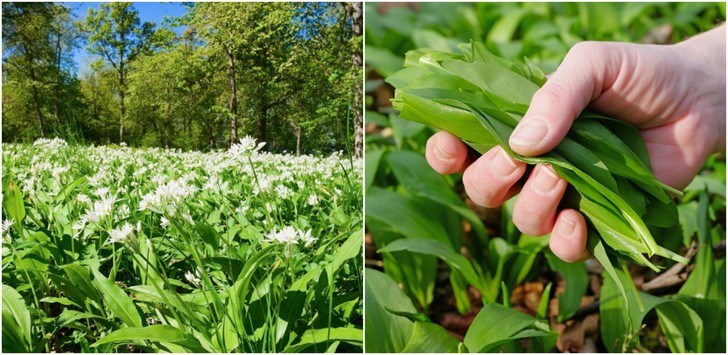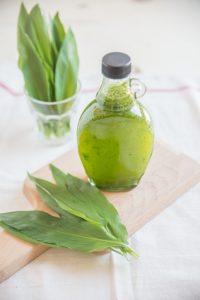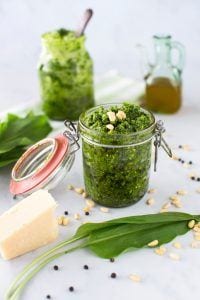
Wild garlic, also known as ramsons or ramps, grows free in abundance on many lands open to foraging. In North America, it’s widespread across the eastern U.S. and eastern Canada, growing all the way from Missouri and Minnesota, as far north as Quebec and in higher elevations in the south, though it can also be found in areas along the west coast. It’s a distant relative of chives that delivers a particularly unique take on this, especially ubiquitous ingredient. You don’t eat the bulbs, rather the pungent leaves. It’s something that’s commonly used among Native Americans for both healing and cooking purposes, and it’s often featured in Central Appalachian dishes.
If you’re interested in dabbling in wild foods, wild garlic is a great one to start with. You can harvest your own if you know what to look for.
Foraging For Wild Garlic
If you’re really lucky and you notice that your lawn looks as if it’s covered in chives, you might have your very own free source of tasty wild garlic. Of course, most people aren’t that fortunate, so you’ll probably have to go out and find it but that’s all part of the fun. Just make sure that you’re on public access lands. The best spots tend to be areas with sheltered, light woodlands that are close to a source of water. You’ll probably smell it before you see it as it fills the area with a scent that is likely to remind you of a strong spring onion. If it doesn’t have a smell like garlic or onions, it’s not wild garlic but it may be Star of Bethlehem, a toxic member of the lily family, something you definitely don’t want to harvest. If you aren’t sure, leave it.
The smell of wild garlic is your best bet for identifying it. Simply follow your nose. If you live in a rural area near a forested river bottom and discover a plant that has large, wide leaves and smells like garlic, you’ve probably found it, but the flowers are a dead giveaway. They’re white, thin, delicate, and form into a rough globe that looks like an exploding fireworks display.
5 Health Benefits of Wild Garlic
Wild garlic is a collection of species in the Allium genus and offers many of the same characteristics as the garlic cloves you’ve probably been using for years. Medicinally speaking, it can certainly be considered a superfood. It’s known as the most effective broad-spectrum antimicrobial agent with nearly 40 different anti-fungal, anti-inflammatory, bacterial, parasitic and viral agents.
Plants in the allium family like garlic, contain a compound known as allicin, which is not only responsible for the distinct smell, but for its many potential biological effects that can help cure many different ailments and support good overall health.
1. A natural antibiotic
This flavorful plant may best be known for flavoring dishes, but it’s also one of the best natural antibiotics on Earth. Research in 2012 from Washington State University found that it was 100 times more effective than two of the most commonly used antibiotics for fighting off a bacteria called Campylobacter, something that’s responsible for multiple intestinal ailments around the world. It can even kill strains of staph and bacteria that have become immune to modern antibiotics. This is something we’ve known for centuries, long before science ever proved its abilities. In fact, garlic has been used for thousands of years as a healing agent, even utilized to ward off the plague in the 18th century.
Wild garlic is an incredible food as it doesn’t just kill bacteria, but viruses, fungi, and pathogens, without harming healthy gut flora. It’s jam-packed with phytochemicals and healing sulfur components, guards against DNA damaged with its potent antioxidant properties and is even known to fight parasites and worms. It also provides a wealth of nutrients, like B vitamins and vitamin C, as well as minerals such as calcium, iron, and magnesium. It should really be a staple in everyone’s diet.
2. Detoxification
As mentioned, wild garlic offers many beneficial properties for the body. Other than its use as a natural antibiotic, it’s ability to detoxify, removing harmful toxins from the body, may be the most important. Keeping the body free of toxins and other potentially harmful substances is one of the key factors in overall health and longevity. A 2012 study published in the journal Basic & Clinical Pharmacology demonstrated that garlic was just as effective at eliminating lead from the body as d-penicillamine, minus the serious side effects.
Lead poisoning, as the researchers noted, accounts for 0.2 percent of all deaths worldwide. Unfortunately, the heavy metal that was once commonly used in paints, is still used in some places today despite the fact that it’s widely known to potentially cause damage to the digestive, cardiovascular and skeletal systems, with particularly devastating impacts on the reproductive organs, nervous system, and kidneys. It is known to have significant negative effects on the kidneys, nervous system and reproductive organs.
Of course, the detoxifying properties of garlic don’t just apply to lead, but the long list of other toxins we’re all exposed to from day to day. There are toxins in many of the foods we consume, in the air we breathe, in cleaning products, secondhand smoke and more.
3. Supporting good cardiovascular health through better blood pressure and cholesterol levels
The instance of cardiovascular disease is typically lower in populations that consume lots of garlic. One of the reasons for that may be that garlic has the ability to reduce high blood pressure, or hypertension. A 2013 study out of Saudi Arabia’s King Khalid University published in the Pakistan Journal of Pharmaceutical Sciences, revealed that garlic was at least as effective as the powerful blood pressure lowering medication atenolol for decreasing both systolic and diastolic blood pressure in participants who’d been diagnosed with essential hypertension.
Garlic can also help improve cholesterol levels, further supporting heart health. It lowers both overall cholesterol and LDL, otherwise known as the “bad” cholesterol as shown in numerous studies. On average, studies have shown that it may reduce LDL and total cholesterol by about 15 percent.
4. Regulating blood sugar levels
A 2012 study on diabetic rabbits found that garlic offers hypoglycemic effects, meaning that it can help lower or maintain normal blood sugar levels. A review of studies in 2014, also supported the idea that consuming garlic regularly can help lower blood glucose levels.
5. Slowing the aging process and preventing brain aging diseases like dementia and Alzheimer’s
When your body suffers from oxidative damage caused by free radicals, that serves to speed aging. Wild garlic provides antioxidants that help to support the body’s defenses to protect against oxidative damage. Multiple studies have found that garlic has been linked to increased antioxidant enzymes in addition to the ability to reduce oxidative stress. The combined effects of lowering both cholesterol and blood pressure, coupled with garlic’s potent antioxidant properties, may help prevent common brain aging diseases such as dementia and Alzheimer’s.
Wild Garlic Recipes
There are so many delicious ways to make use of your wild garlic, you’ll want to get out there and start foraging now. You can use it in pretty much any dish where you’d use garlic or leeks. While the leaves are tasty raw they can be a bit too garlicky for most, but you may be able to use them with more mild tasting greens in a salad. Cooking tempers the flavor significantly, so you can also wilt the young leaves and stems, similar to spinach, or add them to a soup.
Here are some other ideas to get you started.
 Wild Garlic Olive Oil
Wild Garlic Olive Oil
Ingredients:
- 2 cups wild garlic leaves
- 2 cups organic, cold-pressed olive oil
- 1 tsp sea salt
Directions:
Thoroughly wash, rinse and dry your wild garlic leaves and then place them in a high powered blender or food processor. Add the olive oil and salt, and then blend into a puree. Store the oil in a lidded glass jar, placing an extra layer of olive oil on top to preserve it. If you don’t plan to use it all within a week or so, freeze it in ice cube trays and then place the frozen cubes into a Ziploc-style bag.
Wild Garlic ‘No-Mayo’ Mayonnaise Substitute
Ingredients:
- 2 ripe avocados
- 1/2 cup cashews, pine nuts, or hemp hearts
- A handful of wild garlic leaves
- 3-4 sprigs of parsley
- 2 tbsp organic olive oil
- Juice of half of one lemon
- 1/2 cup of water
- Pinch of salt, paprika, and chili or cayenne powder
Directions:
Add all ingredients to a large bowl and blend until smooth. If you need to, add more water. Store what isn’t immediately used in a lidded glass jar, pouring a bit of olive oil on top to preserve it.
 Wild Garlic Pesto
Wild Garlic Pesto
Ingredients:
- 3/4 cup wild garlic greens
- 3/4 cup, parmesan cheese, grated
- 3/4 cup pine nuts
- 3/4 cup organic olive oil
- Sea salt and pepper to taste
Instructions:
Wash, rinse and pat dry your wild garlic greens, removing any long stems. Place the wild garlic greens, parmesan cheese, and pine nuts into a food processor. Blitz and slowly add the olive oil, continuing to blitz until the pesto achieves a consistency you prefer. Season with sea salt and pepper. If you don’t have a blender you can use the old fashioned way and grind all ingredients with a pestle and mortar until a paste is formed.

 Wild Garlic Olive Oil
Wild Garlic Olive Oil Wild Garlic Pesto
Wild Garlic Pesto